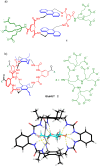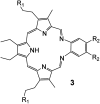Making molecules work - stories of supramolecular translation
- PMID: 40740747
- PMCID: PMC12306639
- DOI: 10.1039/d5sc90071a
Making molecules work - stories of supramolecular translation
Abstract
Commercialising supramolecular chemistry has proved challenging, but encouraging stories are beginning to emerge. In this editorial we present accounts of programs aimed at diabetes management, humidity sensing, antimicrobials, shock absorbing materials, nitrate sensing and anti-cancer agents. The experiences of the authors are intended to help others following similar paths, assisting efforts to develop real-world applications of functional molecules.
This journal is © The Royal Society of Chemistry.
Conflict of interest statement
APD is a founder and shareholder of Carbometrics. JFA, KK and JLS are co-founders of INNOVOTEX, Inc. and have an equity stake in the company. The remaining authors have no conflicts of interest to report.
Figures











Similar articles
-
Systemic pharmacological treatments for chronic plaque psoriasis: a network meta-analysis.Cochrane Database Syst Rev. 2020 Jan 9;1(1):CD011535. doi: 10.1002/14651858.CD011535.pub3. Cochrane Database Syst Rev. 2020. Update in: Cochrane Database Syst Rev. 2021 Apr 19;4:CD011535. doi: 10.1002/14651858.CD011535.pub4. PMID: 31917873 Free PMC article. Updated.
-
The Lived Experience of Autistic Adults in Employment: A Systematic Search and Synthesis.Autism Adulthood. 2024 Dec 2;6(4):495-509. doi: 10.1089/aut.2022.0114. eCollection 2024 Dec. Autism Adulthood. 2024. PMID: 40018061 Review.
-
Fabricating mice and dementia: opening up relations in multi-species research.In: Jenkins N, Jack-Waugh A, Ritchie L, editors. Multi-Species Dementia Studies. Bristol (UK): Bristol University Press; 2025 Feb 25. Chapter 2. In: Jenkins N, Jack-Waugh A, Ritchie L, editors. Multi-Species Dementia Studies. Bristol (UK): Bristol University Press; 2025 Feb 25. Chapter 2. PMID: 40690569 Free Books & Documents. Review.
-
Group-based interventions to reduce gambling involvement among male football fans: a synopsis of findings from a feasibility study.Public Health Res (Southampt). 2025 Jul;13(6):1-24. doi: 10.3310/SWWP9393. Public Health Res (Southampt). 2025. PMID: 40690427
-
Systemic pharmacological treatments for chronic plaque psoriasis: a network meta-analysis.Cochrane Database Syst Rev. 2021 Apr 19;4(4):CD011535. doi: 10.1002/14651858.CD011535.pub4. Cochrane Database Syst Rev. 2021. Update in: Cochrane Database Syst Rev. 2022 May 23;5:CD011535. doi: 10.1002/14651858.CD011535.pub5. PMID: 33871055 Free PMC article. Updated.
References
-
- IDF Diabetes Atlas, ed. E. J. Boyko, D. J. Magliano, S. Karuranga, L. Piemonte, P. Riley, P. Saeedi and H. Sun, International Diabetes Federation, 10th edn, 2021
-
- Davis A. P. Wareham R. S. Carbohydrate recognition through noncovalent interactions: A challenge for biomimetic and supramolecular chemistry. Angew. Chem., Int. Ed. 1999;38:2978–2996. - PubMed
-
- Klein E. Crump M. P. Davis A. P. Carbohydrate recognition in water by a tricyclic polyamide receptor. Angew. Chem., Int. Ed. 2005;44:298–302. - PubMed
-
- Ke C. Destecroix H. Crump M. P. Davis A. P. A simple and accessible synthetic lectin for glucose recognition and sensing. Nat. Chem. 2012;4:718–723. - PubMed
Publication types
LinkOut - more resources
Full Text Sources

